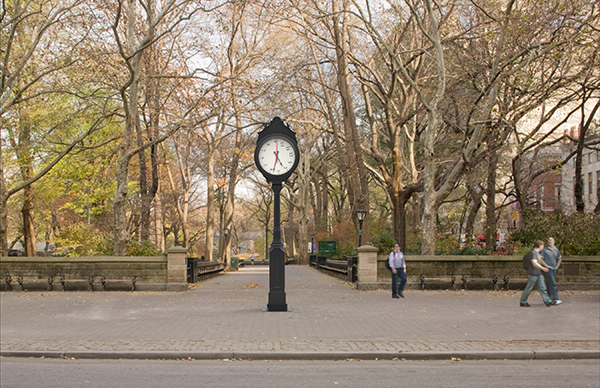
Alicja Kwade will totally befuddle your perception of time and space this fall, with Against the Run, a 16-foot-tall version of the classic New York City street clock that will simultaneously run backward and forward, while still managing to keep the correct time.
“We like to keep it moving—this is New York,” Public Art Fund director Nicholas Baume told artnet News in a phone conversation. “It’ll be a nice way to kind of kick off the fall season.”
The installation, which will appear next month at Central Park’s Doris C. Freedman Plaza, is being organized by the Public Art Fund, with Baume curating.
Kwade’s uncannily perplexing artwork will mark the Polish-born, Berlin-based artist’s first solo public art commission in the US. Her work was included in the most recent edition of Art Basel’s Parcours sector, and was previously included in the Public Art Fund’s 2013 group show at City Hall Park, “Lightness of Being.”
“I’ve been interested in her work for several years,” said Baume. “I think she’s one of the bright young talents who is coming out of Berlin at the moment.”
Alicja Kwade, Against the Run (2015), rendering.
Photo: Alicja Kwade, courtesy König Galerie, Berlin; and 303 Gallery, New York.
Against the Run, specifically conceived for the Central Park space, will see the clock face itself rotate counterclockwise, moving in direct opposition to the second hand, which will appear to stand still. The minute and hour hands will function normally, and the clock will always indicate the correct time despite simultaneously running in reverse.
This seeming contradiction of conventional time-telling is bound to cause some head-scratching among viewers, but that’s just the way Kwade likes it.
The artist enjoys creating work that appears to challenge scientific laws and social conventions by distorting our visual perception of familiar objects like clocks, lamps, or mirrors. Kwade invites us to reconsider what is actually real, and explore the possibilities of the imagination.
Alicja Kwade, Against the Run (2015), rendering.
Photo: Alicja Kwade, courtesy König Galerie, Berlin; and 303 Gallery, New York.
Baume described Kwade’s work as “elegant, both formally and conceptually.”
For Against the Run, Kwade has completely subverted the normal, everyday experience of telling time, a learned task that becomes second nature. “We find it very hard to process that information if it’s given to us differently,” said Baume. “We expect it to behave in a certain way, and when it doesn’t it’s kind of more confusing than it should be, simply because we’re perceptually and conceptually bound by conventions.”
Baume compares this element of the work to the US’s continued adherence on the Imperial measurement system of inches and feet, in a world where the decimal system is the standard.
“What Kwade’s work does is break a lot of the systems that govern our lives and are quite arbitrary.”
The work will be the follow-up to Public Art Fund’s spring Central Park exhibition, Tatiana Trouvé’s Desire Lines, which closes August 30.
Alicja Kwade’s Against the Run will be on view at Central Park’s Doris C. Freedman Plaza September 10, 2015–February 14, 2016.
Related Stories:
13 Gorgeous and Hilarious Instagram Photos of Public Art Installations
The Public Art Fund Brings Digitally Manipulated Sculpture to City Hall Park
Hank Willis Thomas Speaks the Truth in 22 Languages